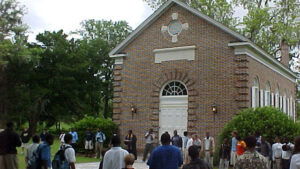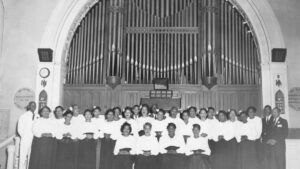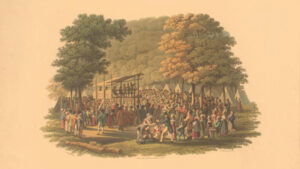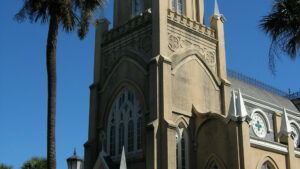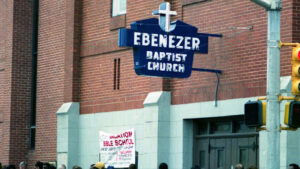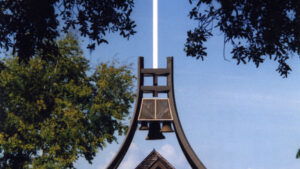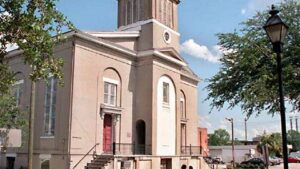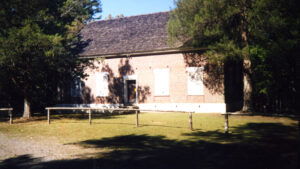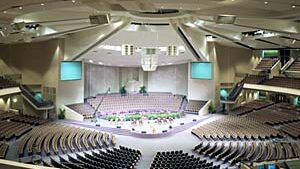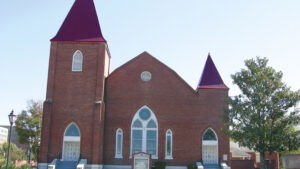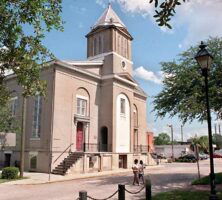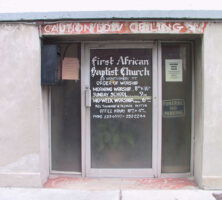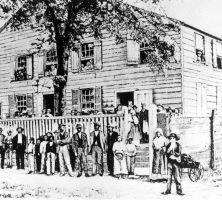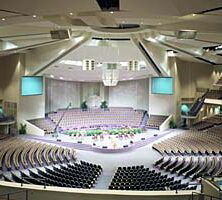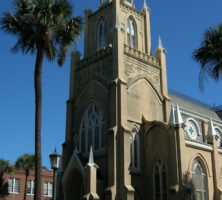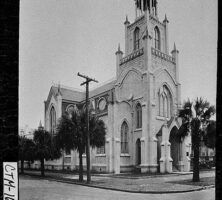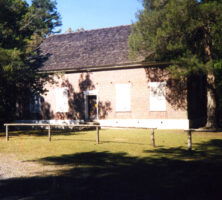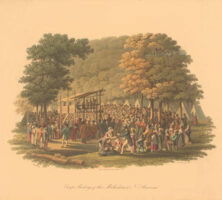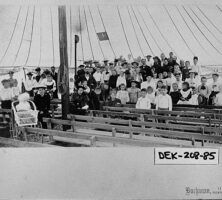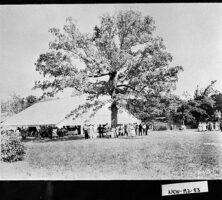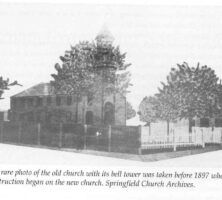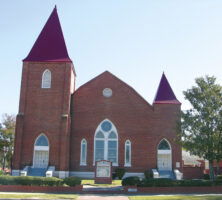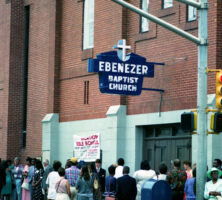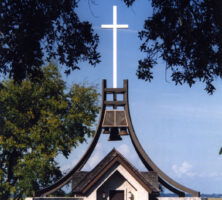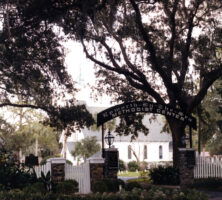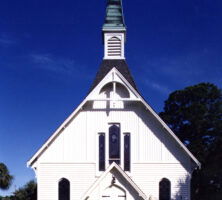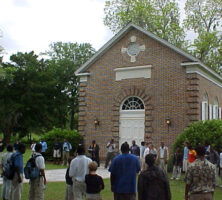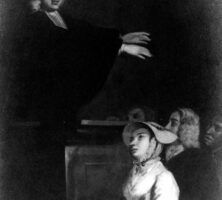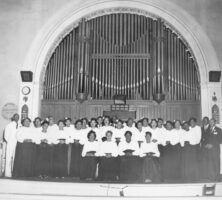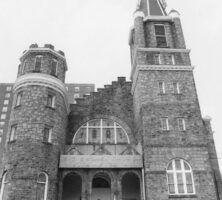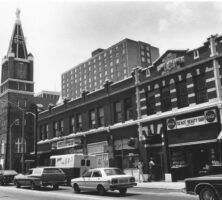The New Georgia Encyclopedia is supported by funding from A More Perfect Union, a special initiative of the National Endowment for the Humanities.
First African Baptist Church, which was established during the 1770s, played an important part in the Savannah civil rights movement. The stained-glass windows in the current church building, located at 23 Montgomery Street in Savannah, feature prominent Black leaders.
Photograph by Carl Elmore. Courtesy of Savannah Morning News
The New Georgia Encyclopedia does not hold the copyright for this media resource and can neither grant nor deny permission to republish or reproduce the image online or in print. All requests for permission to publish or reproduce the resource must be submitted to the rights holder.
A museum housing artifacts and church memorabilia dating to the eighteenth century is housed on the grounds of First African Baptist Church in Savannah. One of the oldest Black churches in the nation, First African has occupied its current site on Montgomery Street since 1859.
Photograph by Sarah E. McKee, New Georgia Encyclopedia
The New Georgia Encyclopedia does not hold the copyright for this media resource and can neither grant nor deny permission to republish or reproduce the image online or in print. All requests for permission to publish or reproduce the resource must be submitted to the rights holder.
This post-Civil War sketch depicts members of Savannah's First Bryan Baptist Church, named after early Baptist minister Andrew Bryan, congregating outside the church building. The church is one of the oldest Black churches in North America.
Photograph by James M. Simms
The New Georgia Encyclopedia does not hold the copyright for this media resource and can neither grant nor deny permission to republish or reproduce the image online or in print. All requests for permission to publish or reproduce the resource must be submitted to the rights holder.
The main sanctuary of New Birth Missionary Baptist Church, a megachurch in Atlanta, holds 7,500 people. The use of state-of-the-art technology, including lighting, sound systems, and wide-screen video monitors, is a hallmark of the worship experience in many megachurches.
Courtesy of the Sizemore Group, the Architects
The New Georgia Encyclopedia does not hold the copyright for this media resource and can neither grant nor deny permission to republish or reproduce the image online or in print. All requests for permission to publish or reproduce the resource must be submitted to the rights holder.
The New Georgia Encyclopedia does not hold the copyright for this media resource and can neither grant nor deny permission to republish or reproduce the image online or in print. All requests for permission to publish or reproduce the resource must be submitted to the rights holder.
Savannah Christian Church, a megachurch in Savannah, operates a bookstore on the church campus. Many megachurches offer a variety of services and facilities to their members, including bookstores, gymnasiums, information centers, and shuttle services.
Courtesy of Savannah Christian Church
The New Georgia Encyclopedia does not hold the copyright for this media resource and can neither grant nor deny permission to republish or reproduce the image online or in print. All requests for permission to publish or reproduce the resource must be submitted to the rights holder.
Congregation Mickve Israel, founded in 1733, is the oldest Jewish congregation in the South. The current synagogue, erected in Savannah between 1876 and 1878, is designed in the Gothic style and features a museum documenting the congregation's history.
Photograph by Kelly Caudle, New Georgia Encyclopedia
The New Georgia Encyclopedia does not hold the copyright for this media resource and can neither grant nor deny permission to republish or reproduce the image online or in print. All requests for permission to publish or reproduce the resource must be submitted to the rights holder.
Congregation Mickve Israel, pictured circa 1930, was built in 1878 on Bull Street, on the east side of Monterey Square. The synagogue is listed on the National Register of Historic Places.
Courtesy of Georgia Archives, Vanishing Georgia, #
ctm162.
The New Georgia Encyclopedia does not hold the copyright for this media resource and can neither grant nor deny permission to republish or reproduce the image online or in print. Requests for permission to publish or reproduce the resource should be submitted to the Georgia Archives.
Kiokee Baptist Church, located today in Appling, is the oldest Baptist church still active in Georgia. Pictured is the church's third building, which was constructed in 1808 several miles outside Appling in Columbia County.
Courtesy of Jarrett Burch
The New Georgia Encyclopedia does not hold the copyright for this media resource and can neither grant nor deny permission to republish or reproduce the image online or in print. All requests for permission to publish or reproduce the resource must be submitted to the rights holder.
The Shrine of the Black Madonna in Atlanta was founded in 1975 as the ninth congregation of the Pan African Orthodox Christian Church. The tradition combines elements of Roman Catholic, charismatic, and African religious rituals, and each church operates a cultural center and bookstore.
Photograph by Darby Carl Sanders, New Georgia Encyclopedia
The New Georgia Encyclopedia does not hold the copyright for this media resource and can neither grant nor deny permission to republish or reproduce the image online or in print. All requests for permission to publish or reproduce the resource must be submitted to the rights holder.
A hand-colored aquatint by M. Dubourg depicts a Methodist camp meeting held in North America, circa 1819. Camp meetings were a common event during the years of the Second Great Awakening, a series of Protestant revivals held between 1790 and 1830.
Courtesy of Library of Congress, Prints and Photographs Division
The New Georgia Encyclopedia does not hold the copyright for this media resource and can neither grant nor deny permission to republish or reproduce the image online or in print. All requests for permission to publish or reproduce the resource must be submitted to the rights holder.
The New Georgia Encyclopedia does not hold the copyright for this media resource and can neither grant nor deny permission to republish or reproduce the image online or in print. All requests for permission to publish or reproduce the resource must be submitted to the rights holder.
Participants in a camp meeting, held in DeKalb County around 1900, gather for a photograph inside the tabernacle. The first documented camp meeting in Georgia occurred in 1803 on Shoulderbone Creek in Hancock County.
Courtesy of Georgia Archives, Vanishing Georgia, #
dek208-85.
The New Georgia Encyclopedia does not hold the copyright for this media resource and can neither grant nor deny permission to republish or reproduce the image online or in print. Requests for permission to publish or reproduce the resource should be submitted to the Georgia Archives.
The tabernacle, or arbor, at Salem Camp Ground in Newton County, pictured in 1931, is representative of the architectural form that served as the centerpiece of camp meeting grounds throughout the South. Salem Camp Ground, which was added to the National Register of Historic Places in 1998, continues to hold annual meetings.
Courtesy of Georgia Archives, Vanishing Georgia, #
new192-83.
The New Georgia Encyclopedia does not hold the copyright for this media resource and can neither grant nor deny permission to republish or reproduce the image online or in print. Requests for permission to publish or reproduce the resource should be submitted to the Georgia Archives.
Purchased by Springfield Baptist Church in 1844, the Asbury Chapel of St. John Methodist Church in Augusta was built in 1801. It served as the church building for Springfield Baptist until around 1897, when construction began on a new structure.
From Old Springfield: Race and Religion in Augusta, Georgia, by E. Cashin
The New Georgia Encyclopedia does not hold the copyright for this media resource and can neither grant nor deny permission to republish or reproduce the image online or in print. All requests for permission to publish or reproduce the resource must be submitted to the rights holder.
Springfield Baptist Church in Augusta, founded in 1773, is one of the oldest Black congregations in the United States. The cornerstone for the current church building was laid in 1897.
Courtesy of Augusta Convention and Visitors Bureau
The New Georgia Encyclopedia does not hold the copyright for this media resource and can neither grant nor deny permission to republish or reproduce the image online or in print. All requests for permission to publish or reproduce the resource must be submitted to the rights holder.
Springfield Baptist Church, pictured in 2005, is one of the oldest African American churches in the country. The sanctuary features stained glass windows and a baptismal font.
Courtesy of Augusta Convention and Visitors Bureau
The New Georgia Encyclopedia does not hold the copyright for this media resource and can neither grant nor deny permission to republish or reproduce the image online or in print. All requests for permission to publish or reproduce the resource must be submitted to the rights holder.
The Ebenezer Baptist Church in downtown Atlanta—in which King was ordained and from which he conducted many of his civil rights campaigns in the 1950s and 1960s—is now preserved as part of the Martin Luther King Jr. Historic Site.
Courtesy of Atlanta Journal-Constitution.
The New Georgia Encyclopedia does not hold the copyright for this media resource and can neither grant nor deny permission to republish or reproduce the image online or in print. All requests for permission to publish or reproduce the resource must be submitted to the Atlanta Journal-Constitution.
The lighted cross atop the Wright Prayer Tower at Epworth by the Sea, a Methodist conference and retreat center on St. Simons Island, overlooks the Frederica River and the Marshes of Glynn.
Photograph by Ed Mathews
The New Georgia Encyclopedia does not hold the copyright for this media resource and can neither grant nor deny permission to republish or reproduce the image online or in print. All requests for permission to publish or reproduce the resource must be submitted to the rights holder.
Epworth by the Sea has grown from a rustic camp facility to a modern Methodist conference and retreat center. Epworth provides "a Christian place for worship, study, and fellowship" to individuals and groups from any denomination.
Photograph by David Miller
The New Georgia Encyclopedia does not hold the copyright for this media resource and can neither grant nor deny permission to republish or reproduce the image online or in print. All requests for permission to publish or reproduce the resource must be submitted to the rights holder.
Lane Chapel is located on the site of the former Hamilton Plantation, which was purchased by the Methodists in 1949 for the establishment of Epworth by the Sea, a retreat and conference center.
Photograph by Ed Mathews
The New Georgia Encyclopedia does not hold the copyright for this media resource and can neither grant nor deny permission to republish or reproduce the image online or in print. All requests for permission to publish or reproduce the resource must be submitted to the rights holder.
Day of Prayer at Bethesda, a home established in 1740 for orphaned boys. Bethesda, near Savannah, is still in operation today.
Courtesy of Bethesda School for Boys
The New Georgia Encyclopedia does not hold the copyright for this media resource and can neither grant nor deny permission to republish or reproduce the image online or in print. All requests for permission to publish or reproduce the resource must be submitted to the rights holder.
The New Georgia Encyclopedia does not hold the copyright for this media resource and can neither grant nor deny permission to republish or reproduce the image online or in print. All requests for permission to publish or reproduce the resource must be submitted to the rights holder.
With funds raised primarily in his native England, Anglican minister George Whitefield opened the Bethesda Orphan House in Savannah in 1740. In 1791 the state assumed control of the orphanage and later opened an academy.
The New Georgia Encyclopedia does not hold the copyright for this media resource and can neither grant nor deny permission to republish or reproduce the image online or in print. Requests for permission to publish or reproduce the resource should be submitted to the Hargrett Manuscript and Rare Book Library at the University of Georgia.
The Big Bethel AME Concert Choir ispictured in 1947 in front of the church's Möller organ. At the time, the choir was under the directorship of Henry J. Furlow. The church and its choirs were known for their many performances, including the world-famous religious pageant.
Courtesy of Archives Division, Auburn Avenue Research Library on African American Culture and History, Atlanta-Fulton Public Library System, HenryJ. and Florine Dyer Furlow Papers..
The New Georgia Encyclopedia does not hold the copyright for this media resource and can neither grant nor deny permission to republish or reproduce the image online or in print. All requests for permission to publish or reproduce the resource must be submitted to the rights holder.
Big Bethel African Methodist Episcopal Church, pictured circa 1975, was organized in 1847. The church went through several sanctuary buildings until the construction of this Romanesque Revival building in the 1920s, by architect J. A. Lankford and builder Alexander Hamilton.
Courtesy of Archives Division, Auburn Avenue Research Library on African American Culture and History, Atlanta-Fulton Public Library System, Ann States Collection.
The New Georgia Encyclopedia does not hold the copyright for this media resource and can neither grant nor deny permission to republish or reproduce the image online or in print. All requests for permission to publish or reproduce the resource must be submitted to the rights holder.
Big Bethel AME, on Auburn Avenue in Atlanta, is pictured circa 1975. Throughout its history, Big Bethel has been a pillar of the Sweet Auburn district., working to maintain the historical integrity of the neighborhood in addition to its ministries.
Courtesy of Archives Division, Auburn Avenue Research Library on African American Culture and History, Atlanta-Fulton Public Library System, Ann States Collection.
The New Georgia Encyclopedia does not hold the copyright for this media resource and can neither grant nor deny permission to republish or reproduce the image online or in print. All requests for permission to publish or reproduce the resource must be submitted to the rights holder.
